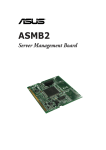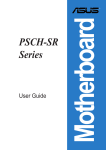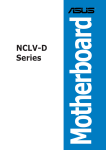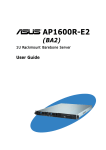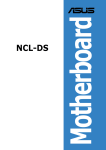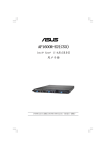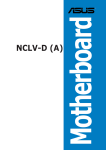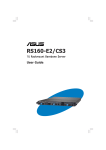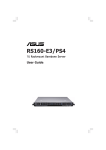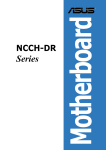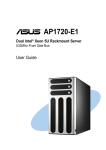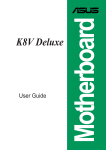Download ASUS ASMB-LE User's Manual
Transcript
ASMB-LE Server Management Board E1743 First edition V1 November 2004 Copyright © 2004 ASUSTeK COMPUTER INC. All Rights Reserved. No part of this manual, including the products and software described in it, may be reproduced, transmitted, transcribed, stored in a retrieval system, or translated into any language in any form or by any means, except documentation kept by the purchaser for backup purposes, without the express written permission of ASUSTeK COMPUTER INC. (“ASUS”). Product warranty or service will not be extended if: (1) the product is repaired, modified or altered, unless such repair, modification of alteration is authorized in writing by ASUS; or (2) the serial number of the product is defaced or missing. ASUS PROVIDES THIS MANUAL “AS IS” WITHOUT WARRANTY OF ANY KIND, EITHER EXPRESS OR IMPLIED, INCLUDING BUT NOT LIMITED TO THE IMPLIED WARRANTIES OR CONDITIONS OF MERCHANTABILITY OR FITNESS FOR A PARTICULAR PURPOSE. IN NO EVENT SHALL ASUS, ITS DIRECTORS, OFFICERS, EMPLOYEES OR AGENTS BE LIABLE FOR ANY INDIRECT, SPECIAL, INCIDENTAL, OR CONSEQUENTIAL DAMAGES (INCLUDING DAMAGES FOR LOSS OF PROFITS, LOSS OF BUSINESS, LOSS OF USE OR DATA, INTERRUPTION OF BUSINESS AND THE LIKE), EVEN IF ASUS HAS BEEN ADVISED OF THE POSSIBILITY OF SUCH DAMAGES ARISING FROM ANY DEFECT OR ERROR IN THIS MANUAL OR PRODUCT. SPECIFICATIONS AND INFORMATION CONTAINED IN THIS MANUAL ARE FURNISHED FOR INFORMATIONAL USE ONLY, AND ARE SUBJECT TO CHANGE AT ANY TIME WITHOUT NOTICE, AND SHOULD NOT BE CONSTRUED AS A COMMITMENT BY ASUS. ASUS ASSUMES NO RESPONSIBILITY OR LIABILITY FOR ANY ERRORS OR INACCURACIES THAT MAY APPEAR IN THIS MANUAL, INCLUDING THE PRODUCTS AND SOFTWARE DESCRIBED IN IT. Products and corporate names appearing in this manual may or may not be registered trademarks or copyrights of their respective companies, and are used only for identification or explanation and to the owners’ benefit, without intent to infringe. ii Contents Contents ............................................................................................. iii Notices ................................................................................................. v Safety information .............................................................................. vi About this guide ................................................................................ vii Typography ....................................................................................... viii ASMB-LE specifications summary ....................................................... ix Chapter 1: Product introduction 1.1 Welcome! .............................................................................. 1-2 1.2 Package contents ................................................................. 1-2 1.3 Board layout ......................................................................... 1-3 1.4 System requirements ........................................................... 1-3 1.5 Network setup ...................................................................... 1-4 Chapter 2: Installation 2.1 Before you proceed .............................................................. 2-2 2.2 Hardware installation ............................................................ 2-2 2.3 Network configuration .......................................................... 2-5 2.4 2.3.1 Running the ASMC utility ........................................ 2-5 2.3.2 Configuring the LAN controller ............................... 2-6 2.3.3 Updating the ASMC-LE firmware ............................ 2-8 Software installation ............................................................ 2-9 2.4.1 Installing the ARC ................................................... 2-9 2.4.2 Launching ARC ...................................................... 2-10 Chapter 3: 3.1 Software support ASUS Remote Console (ARC) ............................................... 3-2 3.1.1 ARC sections .......................................................... 3-2 3.1.2 Connecting to the remote server ........................... 3-5 3.1.3 Retrieving sensor information ................................. 3-7 3.1.4 Displaying all remote server sensors ...................... 3-9 3.1.5 Displaying FRU information ................................... 3-10 3.1.6 Displaying system event logs ............................... 3-11 3.1.7 Adjusting the monitoring settings ........................ 3-12 3.1.8 Controlling the remote server power ................... 3-13 3.1.9 Viewing PET information ....................................... 3-14 iii Contents 3.2 ASUS Host Management Controller Setup .......................... 3-15 3.2.1 Installing and launching the ASUS Host Management Controller Setup utility .................... 3-15 3.2.2 Command fields .................................................... 3-16 3.2.3 Initial ..................................................................... 3-16 3.2.4 View ...................................................................... 3-16 3.2.5 Set ........................................................................ 3-19 3.2.6 Monitor ................................................................. 3-20 3.2.7 Help ...................................................................... 3-20 Appendix: iv Reference information A.1 LAN port for server management ........................................ A-2 A.2 BMC socket ........................................................................... A-4 A.3 Troubleshooting ................................................................... A-7 Notices Federal Communications Commission Statement This device complies with Part 15 of the FCC Rules. Operation is subject to the following two conditions: • This device may not cause harmful interference, and • This device must accept any interference received including interference that may cause undesired operation. This equipment has been tested and found to comply with the limits for a Class B digital device, pursuant to Part 15 of the FCC Rules. These limits are designed to provide reasonable protection against harmful interference in a residential installation. This equipment generates, uses and can radiate radio frequency energy and, if not installed and used in accordance with manufacturer’s instructions, may cause harmful interference to radio communications. However, there is no guarantee that interference will not occur in a particular installation. If this equipment does cause harmful interference to radio or television reception, which can be determined by turning the equipment off and on, the user is encouraged to try to correct the interference by one or more of the following measures: • Reorient or relocate the receiving antenna. • Increase the separation between the equipment and receiver. • Connect the equipment to an outlet on a circuit different from that to which the receiver is connected. • Consult the dealer or an experienced radio/TV technician for help. The use of shielded cables for connection of the monitor to the graphics card is required to assure compliance with FCC regulations. Changes or modifications to this unit not expressly approved by the party responsible for compliance could void the user’s authority to operate this equipment. Canadian Department of Communications Statement This digital apparatus does not exceed the Class B limits for radio noise emissions from digital apparatus set out in the Radio Interference Regulations of the Canadian Department of Communications. This class B digital apparatus complies with Canadian ICES-003. v Safety information Electrical safety • To prevent electrical shock hazard, disconnect the power cable from the electrical outlet before relocating the server. • When adding or removing devices to or from the server, ensure that the power cables for the devices are unplugged before the signal cables are connected. If possible, disconnect all power cables from the existing server before you add a device. • Before connecting or removing signal cables from the server, ensure that all power cables are unplugged. • Seek professional assistance before using an adapter or extension cord. These devices could interrupt the grounding circuit. • Make sure that your power supply is set to the correct voltage in your area. If you are not sure about the voltage of the electrical outlet you are using, contact your local power company. • If the power supply is broken, do not try to fix it by yourself. Contact a qualified service technician or your retailer. Operation safety • Before installing any component to the server, carefully read all the manuals that came with the package. • Before using the product, make sure all cables are correctly connected and the power cables are not damaged. If you detect any damage, contact your dealer immediately. • To avoid short circuits, keep paper clips, screws, and staples away from connectors, slots, sockets and circuitry. • Avoid dust, humidity, and temperature extremes. Do not place the product in any area where it may become wet. • Place the product on a stable surface. • If you encounter technical problems with the product, contact a qualified service technician or your retailer. vi About this guide This user guide contains the information you need when installing and configuring the server management card. How this guide is organized This manual contains the following parts: • Chapter 1: Product introduction This chapter describes the server management board features and the new technologies it supports. • Chapter 2: Installation This chapter provides instructions on how to install the board to the server system and install the utilities that the board supports. • Chapter 3: Software support This chapter tells you how to use the software applications that the server management board supports. • Appendix: Troubleshooting The Appendix lists the common problems that you may encounter when installing or usingthe server management board or any of the bundled utilities. Where to find more information Refer to the following sources for additional information and for product and software updates. 1. ASUS websites The ASUS website provides updated information on ASUS hardware and software products. Refer to the ASUS contact information. 2. Optional documentation Your product package may include optional documentation, such as warranty flyers, that may have been added by your dealer. These documents are not part of the standard package. vii Conventions used in this guide To make sure that you perform certain tasks properly, take note of the following symbols used throughout this manual. D A N G E R / W A R N I N G : Information to prevent injury to yourself when trying to complete a task. C A U T I O N : Information to prevent damage to the components when trying to complete a task. I M P O R T A N T : Instructions that you MUST follow to complete a task. N O T E : Tips and additional information to help you complete a task. Typography Bold text Indicates a menu or an item to select. Italics Used to emphasize a word or a phrase. <Key> Keys enclosed in the less-than and greater-than sign means that you must press the enclosed key. Example: <Enter> means that you must press the Enter or Return key. <Key1+Key2+Key3> If you must press two or more keys simultaneously, the key names are linked with a plus sign (+). Example: <Ctrl+Alt+D> Command Means that you must type the command exactly as shown, then supply the required item or value enclosed in brackets. Example: At the DOS prompt, type the command line: afudos /i[filename] afudos /iP5GD2.ROM viii ASMB-LE specifications summary IPMI features IPMI - CPU 8-bit (80C32) 40 MHz Chipset Winbond 83910 External Bus Address Range 64 Kbyte (4-bank) Internal RAM 256 bytes External RAM 32 Kbytes Flash ROM 128 Kbytes Interrupt I2C, Timer, UART, RTC, LPC Timers 16-bit system timer Watchdog timer Real Time Clock (RTC) System Interface Low Pin Count Supports Keyboard Controller Style (KCS), Server Management Interface Chip (SMIC), and Block Transfer (BT) interfaces Serial/Modem Interface Basic Mode and Terminal Mode LAN Interface IPMI 1.5 Shared LAN Bus Four I2C bus One IPMB bus Two UART bus Features Remote power on/off Remote reboot Upgradeable firmware SNMP Trap DOS-based utility Software support ASUS Remote Console (ARC) ASUS Host Management Controller Utility (DOS-based) 1.5-compliant and supports: Auto monitoring sensor and event logging IPMI Host I/O interface Receiving and logging of event messages IPMB/I2C system interface System Watchdog Timer (ASR) Specifications are subject to change without notice. ix x This chapter describes the server management board features and the new technologies it supports. 1 Product introduction 1.1 Welcome! T h a n k y o u f o r b u y i n g a n A S U S® A S M B - L E s e r v e r m a n a g e m e n t board! The ASUS ASMB-LE is an Intelligent Platform Management Interface (IPMI) 1.5-compliant board that allows you to monitor, control, and manage a remote server from the local or central server in your local area network (LAN). With the proprietary ASUS Remote Console interface, ASMB-LE offers round-the-clock remote server monitoring through component sensors including CPU(s) temperature(s), system temperature, fan rotations, and power supply voltages. The ASMB-LE also records each remote server system event for accurate and efficient troubleshooting. The ASMB-LE comes with a power management feature that allows you to power on/off or reset the remote server giving you full control of power in critical situations. The server management board also comes with a Field Replaceable Unit (FRU) information feature that gathers information on replaceable system components or modules such as the motherboard or backplane model name, serial number, manufacturer, etc. You can use the FRU information when reporting and/or replacing server system components. Before you start installing the server management board check the items in your package with the list below. 1.2 Package contents Check your server management board package for the following items. ASUS ASMB-LE board Support CD User guide If any of the above items is damaged or missing, contact your retailer. 1-2 Chapter 1: Product introduction 1.3 Board layout The ASUS ASMB-LE comes in a BMC package. The illustration below shows the major components of the server management board. BMC heartbeat LED Power LED Firmware chip Server management chip Board connectors * Connects to an IPMB connector on the motherboard, when available. LED indicators The ASMB-LE board comes with two LED indicators: BMC heartbeat LED and Power LED. Refer to the table below for the LED indications. LED Name Status Description LED1 BMC Heartbeat Blinking Off ASMB-LE firmware is in execution. The ASMB-LE firmware is corrupted or the server system standby-power is off. LED2 Power On Off 1.4 The managed server system is on. The managed server system is off. System requirements Before you install the ASMB-LE board, check if your server system meets the following requirements: • ASUS server motherboard with Baseboard Management Controller (BMC) socket* • LAN (RJ-45) port for server management** • Microsoft® Internet Explorer 5.5 or later * Visit the ASUS website (www.asus.com) for an updated list of server motherboards that support the ASMB-LE board. ** Refer to the Appendix section for details. ASUS Server Management Board (ASMB-LE) 1-3 1.5 Network setup The ASMB-LE server management board installed on the remote host connects to a local/central server via direct LAN connection or through a network hub. Below are the supported server management configurations. Direct LAN connection RJ-45 cable Remote host with ASMB-LE Local host with ASUS Remote Controller (ARC) LAN connection through a network hub Hub or router Remote host with ASMB-LE 1-4 Local host with ASUS Remote Controller (ARC) Chapter 1: Product introduction This chapter provides instructions on how to install the board to the server system and install the utilities that the board supports. 2 Installation 2.1 Before you proceed Take note of the following precautions before you install the server management board to the server system. 2.2 • Unplug the server system power cord from the wall socket before touching any component. • Use a grounded wrist strap or touch a safely grounded object or to a metal object, such as the power supply case, before handling components to avoid damaging them due to static electricity. • Hold components by the edges to avoid touching the ICs on them. • Whenever you uninstall any component, place it on a grounded antistatic pad or in the bag that came with the component. • Before you install or remove any component, ensure that the power supply is switched off or the power c o r d i s d e t a c h e d f r o m t h e p o w e r s u p p l y . Failure to do so may cause severe damage to the motherboard, peripherals, and/or components. Hardware installation To install the server management board: 1. Remove the server system cover, then locate the Baseboard Management Controller (BMC) socket on the motherboard. Refer to the Appendix section for the location of the BMC socket on supported motherboards. 2. 2-2 Position the board at a 30º-45º angle, then match the notch on the board with the break on the socket. Chapter 2: Installation 3. Carefully push the board to the socket until its connectors (golden fingers) are fully-inserted to the socket. 4. Press the board firmly until the BMC socket retaining clips snap back and secure the board in place. When installed, the board appears as shown. 5. Re-install the server system cover, then connect the power plug to a grounded wall socket. 6. Insert the LAN cable plug to the LAN port for server management. Refer to the Appendix for the location of the LAN port for server management on various server motherboards. 7. For direct LAN configuration, connect the other end of the LAN cable to the local/central server LAN port. For connection to a network hub or router, connect the other end of the LAN cable to the network hub or router. ASUS Server Management Board (ASMB-LE) 2-3 To uninstall the board: 2-4 1. Simultaneously press the BMC socket retaining clips outward until the board tilts up. 2. Carefully pull the board out from the BMC socket, then set aside. Chapter 2: Installation 2.3 Network configuration You must configure the network settings of both the remote server and the local/central server to establish communication and monitor or control the remote server. Prepare the support CD and a bootable floppy disk to configure the network settings. 2.3.1 Running the ASMC utility The ASUS Server Management Card Utility allows you to know the MAC address of the server motherboard and to set the IP address. This utility is available from the support CD that came with the package. To run the ASMC utility: 1. Restart the remote server, then place the support CD to the optical drive. 2. Press <1> (FreeDOS command prompt) when the screen prompts you to select from available boot options. 3. When the A:> prompt appears, type X: (where X is the drive letter of the optical drive). 4. When the X:> prompt appears, type cd\asms\asmc\le\dostool, then press <Enter>. 5. At the prompt, type asmc ?, then press <Enter> to display the ASMC Utility Help Menu. The screen appears as shown. +-----------------------------------------------------+ | ASUS Server Management Card Utility 1.00 Help Menu | +-----------------------------------------------------+ Usage: ASMC -flash -save filename ASMC -flash -load filename ASMC -i2c_read bus_num dev_num offset ASMC -i2c_write bus_num dev_num offset data ASMC ASMC ASMC ASMC ASMC ASMC ASMC ASMC -sdr -save filename -sdr -load filename -kcs[smic/bt/pci_smic] NetFn command data.... -tco enable[disable] -bmc_ip ip_addr[10.10.10.20] -bmc_mac -pet_ip_mac ip_addr[10.10.10.20] mac_addr[010203040506] -bmc_info Refer to the table on the next page for a description of the help menu options. ASUS Server Management Board (ASMB-LE) 2-5 ASMC Help Menu options Options Description -flash -save filename Save the current firmware to a file -flash -load filename Update the ASMB-LE firmware -i2c_read bus_num dev_num offset Send the read I2C command -i2c_write bus_num dev_num offset data Send the written I2C command -sdr -save filename Save the SDR data to file -sdr -load filename Update the SDR data from file -kcs[smic/bt/pci_smic] NetFn command data.... Send IPMI command -tco enable[disable] Enable or disable TCO mode -bmc_ip ip_addr[10.10.10.20] Write the BMC IP address -bmc_mac Auto-write the BMC MAC addresses -pet_ip_mac ip_addr[10.10.10.20] mac_addr[010203040506] Write the PET destination IP and MAC addresses -bmc_info 2.3.2 Displays the BMC and PET IP and MAC addresses Configuring the LAN controller Before you can establish connection to the ASMB-LE board, you must configure the LAN port for server management being used by the remote server to connect to the local/central server. To configure the LAN port of the remote server: 1. On the prompt, type a s m c - t c o e n a b l e e, then press <Enter>. The screen displays the auto-detected information including the motherboard name, vendor-device code, and the physical address (MAC) of the remote server. A:\>asmc -tco enable Detect MotherBoard -> (PSCH-LR) Detect KCS Interface Bus Dev Fun Vendor-Device MAC ======== ====== ======= ====== ============== =================== PSCH-LR 01 01 00 8086 - 1075 00-11-2F-0F-A2-21 Please shutdown the system (Standby power) to enable TCO mode! A:\> 2. Shutdown the remote server, then disconnect the power plug from the electrical socket to enable the TCO mode. 3. Restart the remote server from the support CD. The TCO (Total Cost Ownership) interface for Intel® Fast Ethernet and Gigabit LAN controllers allows you to manage the remote server system even when its operating system is not fully functional. 2-6 Chapter 2: Installation 4. Run the ASMC utility from the support CD following the instructions in the previous section. 5. Type a s m c - b m c _ i p x x x . x x x . x x x . x x xx, then press <Enter> to assign any IP address to the remote server LAN port. The screen displays the request and response buffer. Write the remote server IP address in a piece of paper for reference. A:\>asmc -bmc_ip 169.254.137.105 Detect MotherBoard -> (PSCH-LR) Detect KCS Interface New BMC IP : 169.254.137.105 A:\> When finished, the utility returns to the DOS prompt. Make sure that the assigned IP address for both remote and local/central servers are in the same subnet. You can use the network settings utility in your OS to check. 6. Type a s m c - b m c _ m a c on the prompt, then press <Enter>. The screen displays the physical address (MAC) of the remote server. Write the MAC address in a piece of paper for reference. A:\>asmc -bmc_mac Detect MotherBoard -> (PSCH-LR) Detect KCS Interface Bus Dev Fun Vendor-Device MAC ======== ====== ======= ====== ============== =================== PSCH-LR 01 01 00 8086 - 1075 00-11-2F-0F-A2-21 New BMC MAC: 00 11 2F 0F A2 21 A:\> 7. Type a s m c - b m c _ i n f o on the prompt, then press <Enter> to display the IP and MAC addresses of the BMC and PET. A:\>asmc -bmc_mac Detect MotherBoard -> (PSCH-LR) Detect KCS Interface BMC IP : 169.254.137.105 BMC MAC: 00 11 2F 0F A2 21 PET IP : 169.254.137.106 PET MAC: 00 E0 18 9B BB 44 A:\> 8. Restart the remote server, enter the BIOS setup, then boot from the hard disk drive. 9. Adjust the local/central server network settings, if necessary. ASUS Server Management Board (ASMB-LE) 2-7 2.3.3 Updating the ASMC-LE firmware You can use the ASUS System Web-based Management (ASWM) application to update the ASMC-LE firmware. To do this: 1. Download the latest ASMB-LE firmware from the ASUS website (www.asus.com), then save the firmware file to the server. 2. Launch the ASWM application. If ASWM is not yet installed on your server system, use the support CD to install the application. 3. Click the Configuration link, then select IPMI Flash from the menu. 3 4 5 4. 5. 2-8 Click B r o w s e to locate the latest firmware you downloaded earlier. When selected, the firmware path and filename appears in the F i r m w a r e I m a g e N a m e field. Click A p p l y to update the ASMC-LE firmware. Chapter 2: Installation 2.4 Software installation You can monitor, control, or manage the remote server from the local/central server using the ASUS Remote Console (ARC). The ARC is a web-based application available from the support CD that came with the ASMB-LE package. You must install the ARC on the local/central server to access the remote server. 2.4.1 Installing the ARC To install the ARC to the local/central server: 1. Place the support CD to the optical drive. The CD automatically displays the D r i v e r s menu if Autorun is enabled in your computer. If Autorun is NOT enabled in your computer, browse the contents of the support CD to locate the file ASSETUP.EXE from the BIN folder. Double-click the ASSETUP.EXE to run the CD. 2. Click the M a n a g e m e n t S o f t w a r e tab, then click the item I n s t a l l ASUS IPMI Remote Console utility y. ASUS Server Management Board (ASMB-LE) 2-9 3. Follow the installation wizard instructions to install the utility. 2.4.2 Launching ARC To launch the ARC utility: Click S t a r t > A l l P r o g r a m s > A S U S R e m o t e C o n s o l e > A S U S R e m o t e C o n s o l e from the Windows® desktop. or Double-click the ASUS Remote Console icon on the Windows® desktop. 2-10 Chapter 2: Installation This chapter tells you how to use the software applications that the server management board supports. 3 Software support 3.1 ASUS Remote Console (ARC) The ASUS Remote Console (ARC) is a web-based utility that allows you to monitor the remote host’s hardware information including temperatures, fan rotations, voltages, and power. This application also lets you instantly power on/off or reset the remote server. Menu bar Tool bar Navigation window Detail/SEL window Event window Status bar The ARC window is made up of six sections: M e n u bar, T o o l bar, Navigation window, Detail/SEL window, Event window, and Status bar. 3.1.1 ARC sections Menu bar The Menu bar contains all the commands for the ARC application. Click on a menu to display a list of available commands. Menu Available commands Server add, delete, connect, disconnect server or change the server settings View show or hide the tool bar, status bar, navigation, and PET windows Control turn on/off or reset the remote server Edit delete the System Event Log (SEL) or PET log Help view information about the ARC application Tool bar The Tool bar contains buttons corresponding to the most commonly used commands. The Tool bar offers faster access and execution of these commands. Move the mouse pointer over a button to display its function. 3-2 Chapter 3: Software support Navigation window The Navigation window displays the directory of connected and disconnected remote server(s). For multiple monitoring, this window allows you to navigate through the remote servers. Click the All Servers root directory to display all connected and disconnected servers, then click on the server you want to monitor or control. Click before the server connection to display available remote server information including the Sensor Data Record (SDR), Field Replaceable Unit (FRU), and System Event Log (SEL). Sensor groups Sensors Some remote server information (such as the SDR) contains several sensor groups such as T e m p e r a t u r e e, V o l t a g e e, F a n n, and C h a s s i s I n t r u s i o n n. Click before the remote server information to display the sensor groups. Click before a sensor group to display individual sensors. For example, clicking before the sensor group T e m p e r a t u r e displays the CPU1 and system temperatures. You can also change the server directory display by clicking the buttons on top of the window. For example, clicking the I P button displays the remote server IP address instead N ). Selecting I D of the remote server name (N displays the remote server ID instead of the server name or IP address. ASUS Server Management Board (ASMB-LE) 3-3 Detail/SEL window The Detail/SEL window displays the detailed SDR and FRU information, and the System Event Log (SEL). The window provides the link for detailed sensor information or system events and allows you to adjust the sensor threshold values. Event window The Event window displays the Platform Event Trap (PET) received by the ARC. The PET information includes the event index, source IP address, enterprise, community, generic and specific traps, and time ticks. The PET information is a system management alert in SNMP Trap format and is used is used for IPMI alerting as well as alerts using the ASF specification. Status bar The Status bar located at the bottom of the ARC window displays the connection status to the remote server, connection duration, IP address of the remote server, and the progress of SDR/SEL/FRU information download. 3-4 Chapter 3: Software support 3.1.2 Connecting to the remote server To connect to the remote server: 1. From the menu bar, click S e r v e rr, then select N e w w. An Add new server c o n n e c t i o n window appears. 2. Type the remote server name and IP address on the fields. Click S a v e D e f a u l t to set the remote server connection as the default. Otherwise, click O K to continue or C a n c e l to close the window. The default server connection name and IP address are automatically displayed everytime you add a new server connection. 3. When prompted, select I P M I S e r v e rr, then click C o n t i n u e e. ASUS Server Management Board (ASMB-LE) 3-5 The navigation window displays the remote server. The available remote server information are displayed on the Detail/SEL window. 4. Click before the remote server to display the remote server information, then select from the list. You can also double-click a remote server information from the Detail/SEL window. 5. When prompted, enter the default user name (adm) and password (asusadm). 6. Set the connection request level authentication and privilege, then click O K K. The default connection request level authentication is M D 2 (Message Digest Algorithm 2) with A d m i n i s t r a t o r privileges. You may change these configuration according to your network settings or preference. 3-6 Chapter 3: Software support 3.1.3 Retrieving sensor information The Sensor Data Record (SDR) provides remote server system information through available sensors including CPU/system/power temperatures, voltages, fan speeds, chassis intrusion, etc. The SDR also provides information on the sensor location (e.g. CPU1, CPU2, FAN1), event generation, and access information. To retrieve a sensor information: 1. From the navigation window, click before the server name to display the remote server information. 2. Click before the S D R to display the sensor groups (e.g. Temperature), then click before a sensor group to display the individual sensors. Select a sensor (e.g. CPU1 THERMAL) to display its values in the Detail/SEL window. The Detail/SEL window displays the sensor data attributes, values, and meanings. From this window, you can adjust the sensor threshold values by clicking the up/down arrow button after each value. ASUS Server Management Board (ASMB-LE) 3-7 3. Click M o r e e. A sensor window appears displaying additional information on the sensor. The I n f o r m a t i o n tab displays basic sensor information including the sensor name, current status, current value, and sensor type. The tab also displays the sensor record ID and SDR version. 4. Click the S e t t i n g s tab to adjust the sensor threshold values. Click on the up/down arrow button after each threshold value to adjust. Click O K to close the window. 3-8 Chapter 3: Software support 3.1.4 Displaying all remote server sensors To display all remote server sensors in graphical format: 1. From the navigation window, click the remote server information. 2. Click A l l S e n s o r s v a l u e e. All remote server sensors are displayed on the Information window in graphical format. before the server name to open The color bar represents the upper/lower threshold values of each sensor. The green pointer indicates the current value of the sensor. ASUS Server Management Board (ASMB-LE) 3-9 3.1.5 Displaying FRU information The Field Replaceable Unit (FRU) information provides the manufacturer, product name, and/or serial number of various modules and components installed on the remote server. For example, the FRU feature can display the remote server motherboard name, model, and serial number. You can use this feature when retrieving information on a module or component installed on the remote server. The FRU information feature allows you to obtain component or module information even when the remote server is down or off. To display the FRU information: 1. From the navigation window, click the remote server information. 2. Click before the F R U to display available FRU information, then click before the module/component. Select a module or component from the list to display the FRU information in the Detail/SEL window. 3-10 before the server name to open Chapter 3: Software support 3.1.6 Displaying system event logs The System Event Log (SEL) is a non-volatile storage area where all remote server system events are stored for real-time tracking or later retrieval. The ARC application can display system events for efficient remote server monitoring and troubleshooting. To display the sytem events: 1. From the navigation window, click before the server connection, then click S E L L. The status bar displays the progress of the SEL download. When finished, the Detail/SEL window displays the system events in chronological order. 2. Double-click an event to display an E v e n t I n f o r m a t i o n window. This window displays the sensor type and record ID, event message, current and threshold values, and other system event information. 3. Click OK to close the window. ASUS Server Management Board (ASMB-LE) 3-11 3.1.7 Adjusting the monitoring settings The ARC application allows you to adjust the remote server monitoring settings including SEL polling, SDR reading, ASF, and PET. To adjust the monitoring settings: 1. Click S e r v e r on the menu bar, then select S e t t i n g from the drop-down menu. A S e r v e r S e t t i n g window appears. 2. Click on the up/down arrow button after each setting to adjust the value. Click O K to save your changes and close the window. Otherwise, click C a n c e l to ignore your changes. 3. 3-12 Chapter 3: Software support 3.1.8 Controlling the remote server power The ASMB-LE board through the ARC application allows you to power up, power down, or reset the remote server using the power menu. Before turning off or resetting the remote server, make sure that it is not being used and that no application is currently running to avoid data loss. To power down the remote server: 1. Click C o n t r o l on the menu bar, then select P o w e r d o w n from the drop-down menu. OR Click the power down button on the tool bar. 2. Click Y e s when the C o n f i r m p o w e r d o w n window appears. 3. The remote server is turned off. Click O K to close the window. Use the same instructions as reference when powering up or resetting the remote server. ASUS Server Management Board (ASMB-LE) 3-13 3.1.9 Viewing PET information The Platform Event Trap or PET is an SNMP trap used for system management alerts. When the ARC receives a PET, it displays a pop-up window notifying you of the alert and its source (IP address). Right-click the window to close. You need to install an SNMP service to the remote server to receive PET information. I m p o r t a n t n o t i c e f o r W i n d o w s® X P ( S e r v i c e P a c k 2 ) u s e r s If the remote server system is behind a firewall, you must create a UDP port to receive PET information. To create a UDP port: Double-click the M y C o m p u t e r icon from the Windows® desktop, then click the M y N e t w o r k P l a c e s link. 2. Click the V i e w n e t w o r k c o n n e c t i o n s link, then select the LAN connection the remote server system is using. 3. Right-click the LAN connection, then select P r o p e r t i e s from the drop-down menu. 4. Click the A d v a n c e d tab, then click the S e t t i n g s button. 5. On the S e r v i c e s tab, click the A d d button to display a S e r v i c e S e t t i n g s window. 6. Type a name on the Description of service field (i.e. ASUS ARC). 7. Type the IP address of the local/central server, then set the E x t e r n a l and I n t e r n a l P o r t n u m b e r to 1 6 2 2. 8. Select U D P P, then click O K K. The created service is displayed in the Services list. Check the box before the service, then click O K K. You must also adjust the Internet Explorer settings to allow active contents to run in the local/central server. To do this: 1. 1. 2. 3. 4. 3-14 From the I n t e r n e t E x p l o r e r menu, click T o o l ss, then select I n t e r n e t O p t i o n s from the drop-down menu. Click the A d v a n c e d tab. Allow active content to run in files on My Computer Enable the item “Allow Computer”. Click the A p p l y button, then click O K to close the window. Chapter 3: Software support 3.2 ASUS Host Management Controller Setup The ASUS Host Management Controller Setup utility provides precise configuration and basic functions including System Event Log (SEL) generation and System Data Record (SDR) reading in DOS mode. This utility also supplies configuration sequences for the type of host interface as well as direct real-time monitoring of system information including CPU temperature(s), fan speeds and system voltages. 3.2.1 Installing and launching the ASUS Host Management Controller Setup utility To install the ASUS Host Management Controller Setup utility: 1. Boot the server in DOS mode using the support CD. 2. When the A:> prompt appears, type X: (where X is the drive letter of the optical drive). 3. When the X:> prompt appears, type cd\asms\asmc\le\dostool, then press <Enter>. 4. At the prompt, type asmc, then press <Enter> to display the ASMC Utility Help Menu. The screen appears as shown. A:\>E: E:\>cd\asms\asmc\le\dostool E:\cd\asms\asmc\le\dostool>asmc 5. The main utility screen appears. Press <Enter>. ASUS Server Management Board (ASMB-LE) 3-15 3.2.2 Command fields The utility menu bar has five commands: Initial, View, Set, Monitor and Help. You can select a command using the left or right arrow button on the keyboard. After selecting a command, use the down arrow key to display available options. Select a command, then press <Enter> to execute. Menu options Menu bar 3.2.3 Initial The Initial command allows you to clear the SEL information or exit the utility. Go to I n i t i a l command, then select C l e a r S E L to empty all System Event Log information for a refresh set of data records. Use the C l e a r S E L command when creating a new log that begins at an exact time for precise system monitoring. Select E x i t to close the utility and return to the DOS prompt. 3.2.4 View The V i e w command displays the Baseboard Management Controller (BMC) data record including the S y s t e m E v e n t L o g (SEL), the S y s t e m D a t a R e c o r d (SDR), and general BMC information. 3-16 Chapter 3: Software support To view the System Data Record (SDR): 1. Select B M C S D R from the V i e w command option, then press <Enter>. A complete list of data records appears on the left pane. The right pane displays the sensor data information. The number on the bottom left of the screen indicates the data record displayed in the right window pane over the total number of sensor data records in the remote host. 2. Use the down arrow key to display the next sensor data record. 3. Press <Esc> to return to the main screen. To view the System Event Log (SEL): 1. Select B M C S D R from the V i e w command option, then press <Enter>. A complete list of system event records appear on the left pane. The right pane displayes the SEL information. The number on the left bottom of the window shows the system event displayed in the right window pane over the total number of system events in the remote host. 2. Use the down arrow key to display the next sensor event. 3. Press <Esc> to return to the main screen. ASUS Server Management Board (ASMB-LE) 3-17 To view the BMC information: 1. Select B M C I n f o from the V i e w command option, then press <Enter>. A list of BMC information appears on the left pane. 2. Use the down arrow button to select a BMC information. The BMC information is displayed in the right pane. 3. Press <Esc> to return to the main screen. 3-18 Chapter 3: Software support 3.2.5 Set The S e t command controls the host interface type and the correct BMC time. To select the host interface: 1. Select H o s t I n t e r f a c e from the S e t command option, then press <Enter>. The screen displays the host interfaces supported by the server management board. 2. Use the down arrow button to select a host interface, then press <Enter>. You can select from the following interfaces: KCS Interface SMIC Interface BF Interface PCI Interface 3. - Keyboard Controller Style Server Management Interface Chip Block Transfer Peripheral Component Interconnect When finished, press <Esc> to return to the main screen. To set the BMC Timer: 1. Select B M C T i m e r from the S e t command option, then press <Enter>. 2. Set the BMC IPMI timer to the current system time. 3. When finished, press <Esc> to return to the main screen. ASUS Server Management Board (ASMB-LE) 3-19 3.2.6 Monitor The M o n i t o r command displays real-time data on the remote server system and CPU temperatures, voltages, and fan speeds. To display a remote server information: 1. Select a sensor from the M o n i t o r command options, then press <Enter>. A list of server information appears on the left pane. 2. Use the down arrow button to select a monitor information. The selected monitor information details are displayed in the right pane. 3. Press <Esc> to return to the main screen. 3.2.7 Help The H e l p command displays the available utility options, utility version, and copyright information. 3-20 Chapter 3: Software support The Appendix shows the location of the LAN port for server management on several motherboards and presents common problems that you may encounter when installing or using the server management board. A Reference information A.1 LAN port for server management The ASUS server motherboards that support the ASMB-LE comes with two LAN (RJ-45) ports: one for network connection and the other for server management. You must identify and use the LAN port for server management to connect the remote server to the local/central host (direct LAN connection) or to the network hub or router. Refer to the illustrations below to identify the LAN port for server management on different server motherboards. NCL-DS motherboard PCH-DR motherboard NCCH-DR motherboard A-2 Appendix: Reference information NCLV-D motherboard PSCH-SR motherboard PSCH-LR motherboard ASUS Server Management Board (ASMB-LE) A-3 A.2 BMC socket The ASUS server motherboards that support the ASMB-LE comes with a Baseboard Management Card (BMC) socket. Refer to the illustrations below to locate the BMC socket on different server motherboards. NCL-DS motherboard 33cm (13in) ATXPWR1 PS/2 T: Mouse B: Keyboard CPU_FAN1 REAR_FAN2 DDR DIMM_B4 (64/72 bit, 240-pin module) KBPWR1 DDR DIMM_A4 (64/72 bit, 240-pin module) mPGA 604 USB1 USB2 COM1 ATX12V1 PSUSMB1 FM_CPU1 DDR DIMM_B3 (64/72 bit, 240-pin module) USBPW12 PARALLEL PORT DDR DIMM_A3 (64/72 bit, 240-pin module) DDR DIMM_B2 (64/72 bit, 240-pin module) DDR DIMM_A2 (64/72 bit, 240-pin module) DDR DIMM_B1 (64/72 bit, 240-pin module) REAR_FAN1 Broadcom BCM5721 Intel E7520 MCH RJ-45 (LAN-2) Broadcom BCM5721 RECPVERY1 NCL-DS mPGA 604 VGA1 RJ-45 (LAN-1) LAN1_EN1 SEC_IDE J2 LAN2_EN1 AMI 8Mb FWH 30.5cm (12in) ® DDR DIMM_A1 (64/72 bit, 240-pin module) CPU_FAN2 PCIX1 (64-bit, 133MHz 3V) Super I/O FM_CPU2 PRI_IDE Intel PXH PCIX2 (64-bit, 133MHz 3V) SATA2 SATA1 Intel ICH5R PCIE3 FRNT_FAN1 FRNT_FAN2 VGA_EN1 PCIX4 (64-bit, 133MHz 3V) ATI RAGE XL VGA Controller PCIX5 (64-bit, 133MHz 3V) BPSMB1 COM2 Adaptec AIC-7902W SCSIB1 BUZZ1 CLRTC1 FLOPPY1 HDLED1 SCSI_EN1 USB34 AUX_PANEL1 SB_PWR1 Intel PXH USBPW34 CR2032 3V Lithium Cell CMOS Power PCI6 (32-bit, 33MHz 5V) PANEL1 BMCCONN1 34 1 68 35 SCSIA1 PCH-DR motherboard 26.8cm (10.5in) ATXPWR1 PS/2KBMS T: Mouse B: Keyboard ATX12V1 PSUSMB1 KBPWR1 mPGA 604 CPU_FAN2 USBPW12 USB12 Intel E7210 MCH REAR_FAN2 COM1 REAR_FAN1 VGA1 CPU2 DDR DIMM_A1 (64 bit,184-pin module) DDR DIMM_B2 (64 bit,184-pin module) RJ-45 (LAN1) Intel RJ-45 (LAN2) 82547GI Gigabit Ethernet Intel CPU1 30.5cm (12in) mPGA 604 DDR DIMM_A2 (64 bit,184-pin module) DDR DIMM_B1 (64 bit,184-pin module) 6300ESB ICH LAN_EN1 CPU_FAN1 PCIX1 (64-bit, 66MHz 3V) LED1 Intel PCIX2 (64-bit, 66MHz 3V) 82541GI Gigabit Ethernet SEC_IDE1 FRNT_FAN1 FRNT_FAN2 PCI3 (32-bit, 33MHz 5V) Super I/O BMCCONN1 SB_PWR1 COM2 RAID_EN1 4Mbit Flash BIOS SATA_RAID2 PCI2 (32-bit, 33MHz 5V) PROMISE PDC20378 RAID Controller BMCSOCKET1 DSW1 ATI RAGE XL VGA Controller SATA2 RECOVERY1 PCI1 (32-bit, 33MHz 5V) VGA_EN1 SATA_RAID1 LAN_EN2 SATA1 PRI_IDE1 CR2032 3V Lithium Cell CMOS Power AUX_PANEL1 USBPW34 USB34 PRI_RAID1 FLOPPY1 BUZZER1 CLRTC1 BPSMB1 A-4 LPT1 PCH-DR PANEL1 Appendix: Reference information NCCH-DR motherboard 26.8cm (10.5in) ATX12V1 ATXPWR1 mPGA 604 PS/2KBMS T: Mouse KBPWR1 B: Keyboard PSUSMB1 USB12 USBPW12 COM1 REAR_FAN2 LAN_EN1 Intel CPU2 82547GI Gigabit Ethernet Intel mPGA 604 CPU_FAN2 FM_CPU2 DDR DIMM_A1 (64 bit,184-pin module) LAN1 DDR DIMM_A2 (64 bit,184-pin module) LAN2 DDR DIMM_B1 (64 bit,184-pin module) CPU1 DDR DIMM_B2 (64 bit,184-pin module) 30.5cm (12in) VGA MCH E7210 SB_PWR1 REAR_FAN1 FM_CPU1 CPU_FAN1 PCIX1 (64-bit, 66MHz 3V) SATA_RAID1 SATA_RAID2 SATA_RAID3 SATA_RAID4 Intel 82541GI Gigabit Ethernet PCIX2 (64-bit, 66MHz 3V) FRNT_FAN2 LAN_EN2 FRNT_FAN1 Adaptec AIC-8130 PCI3 (32-bit, 33MHz 5V) ATI RAGE XL VGA Controller PCI4 (32-bit, 33MHz 5V) PCI5 (32-bit, 33MHz 5V) Super I/O SATA1 USB34 USBPW34 BMCSOCKET1 CR2032 3V Lithium Cell CMOS Power 8Mbit Flash BIOS CLRTC1 SATA2 Intel ICH 6300ESB SATA_EN1 VGA_EN1 BMCCONN1 SEC_IDE PRI_IDE FLOPPY BPSMB1 AUX_PANEL1 HDLED RECOVERY 8130 LED1 LPT1 COM2 NCCH-DR PANEL1 NCLV-D motherboard 26.8cm (10.5in) SSIPWR1 REAR_FAN1 NCLV-D SSI12V1 mPGA 604 PS/2KBMS T: Mouse KBPWR1 B: Keyboard PSUSMB1 USB12 COM1 USBPW12 DDR DDR_B2 (64 bit,184-pin module) FM_CPU1 DDR DDR_A2 (64 bit,184-pin module) CPU1 DDR DDR_B1 (64 bit,184-pin module) LAN1 mPGA 604 CPU_FAN1 Intel LAN2 MCH E7320 Gigabit LAN BCM5721 CPU2 30.5cm (12in) VGA DDR DDR_A1 (64 bit,184-pin module) LAN_EN1 Gigabit LAN BCM5705E FM_CPU2 REAR_FAN2 CPU_FAN2 PCIX1 (64-bit PCI-X) FRNT_FAN1 PCIX2 (64-bit PCI-X) ATI RAGE XL VGA Controller Adaptec AIC-8130 PCIE3(x4 link) Intel PCI4 (32-bit 5V PCI) SB_PWR1 8Mbit Flash BIOS ICH 6300ESB RECOVERY1 SATA1 PCI5 (32-bit 5V PCI) Super I/O CLRTC1 SATA2 VGA_EN1 SATA_RAID1 SATA_RAID2 SATA_RAID3 SATA_RAID4 FRNT_FAN2 SATA_EN1 LAN_EN2 USB34 BMCSOCKET1 CR2032 3V Lithium Cell CMOS Power HDLED1 AUX_PANEL1 BMCCONN1 SEC_IDE1 PRI_IDE1 BPSMB1 FLOPPY1 USBPW34 8130 LED1 LPT1 COM2 ASUS Server Management Board (ASMB-LE) PANEL1 A-5 PSCH-SR motherboard 25cm (9.8in) PS/2KBMS T: Mouse B: Keyboard ATXPWR1 KBPWR1 PSUSMB1 Intel 82547GI Gigabit Ethernet USB2.0 Top: T: USB1 LAN1 B: USB2 Socket 478 COM1 Intel E7210 (Canterwood-ES) MCH VGA REAR_FAN1 ® REAR_FAN2 PSCH-SR CPU_FAN1 CPU_FAN2 DDR DIMM_A2 (64 bit,184-pin module) LAN_LED1 J6 DDR DIMM_B1 (64 bit,184-pin module) DDR DIMM_B2 (64 bit,184-pin module) LAN_EN1 LAN_EN2 BUZZER1 CLRTC1 FRONT_FAN1 SEC_IDE1 SB_PWR1 BAT1 Intel 30.5cm (12in) ATX12V1 DDR DIMM_A1 (64 bit,184-pin module) LAN2 PCIX1 (64-bit, 66MHz 3V) 82541GI Gigabit Ethernet SATA_RAID4 PRI_IDE1 PCI2 (32-bit, 33MHz 5V) CHASSIS1 Adaptec AIC-8110X Super I/O FRONT_FAN2 PCI3 (32-bit, 33MHz 5V) LOCATOR1 PANEL1 USB34 J5 BPSMB1 FLOPPY1 J4 SATA_RAID1 adaptec AIC-7901X 4Mbit Flash BIOS SASI_EN1 VGA_EN1 ZCRSKT1 BMCSOCKET1 Intel 6300ESB (Hance-Rapid) ICH SATA_RAID2 SATA1 ATI RAGE XL VGA Controller SATA_RAID3 J2 SATA2 COM2 SCSIA1 34 68 1 35 FPSMB1 PSCH-LR motherboard FAN1 PCI1 BUZZER1 4Mbit Firmware Hub BPSMB1 J3 Super I/O USB34 PS2_MS1 PS2_KB1 25cm (9.9in) KBPWR1 RECOVERY1 PANEL1 VGA_EN1 COM1 VGA1 Intel Hance-Rapid ICH CR2032 3V Lithium Cell CMOS Power PRI_IDE1 SEC_IDE1 CHASSIS1 ATI RAGE-XL VGA Controller BMCSOCKET1 CLRTC1 SATA2 PCIX1 LAN_EN1 SATA1 31.1cm (12.2in) Intel 82541GI FLOPPY1 LAN_EN2 PCIX2 MLED1 ® FAN2 FAN3 FAN4 LAN1 Socket 478 Intel 82547GI LAN2 Intel Canterwood-ES MCH USB1 USB2 SW1 LOCLED1 PSCH-LR FAN5 DDR DIMM_A1 (64/72 bit,184-pin module) DDR DIMM_A2 (64/72 bit,184-pin module) FAN6 DDR DIMM_B1 (64/72 bit,184-pin module) SB_PWR1 DDR DIMM_B2 (64/72 bit,184-pin module) ATX Power Connector ATX12V1 A-6 Appendix: Reference information A.3 Troubleshooting This troubleshooting guide provides answers to some common problems which you may encounter while installing and/or using ASUS ASMB-LE. These problems requires simple troubleshooting that you can perform by yourself. Contact the Wireless LAN Technical Support if you encounter problems not mentioned in this section. Problem The local/central server cannot connect to the ASMB-LE board. Solution 1. Check if the LAN cable is connected to the LAN port for server management. See page A-2 for details. 2. Check if the remote server LAN port is working properly. If you have not previously installed the LAN controller driver, install the same using the system support CD. 3. Make sure the IP address of both the remote and local/central servers are on the same subnet. 4. Set the remote server IP address and MAC address using the ASUS Host Management Controller Setup. See Chapter 2 for details. The ARC cannot receive PET information from the remote server. Set the remote server PET IP address and MAC address using the ASUS Server Management Card Utility. See Chapter 2 for details. The ASMC utility cannot set the BMC MAC address or cannot enable TCO. Copy the n i c . i n i file to the ASMC directory, then try again. The n i c . i n i file is available from the support CD. ASUS Server Management Board (ASMB-LE) A-7 A-8 Appendix: Reference information




















































